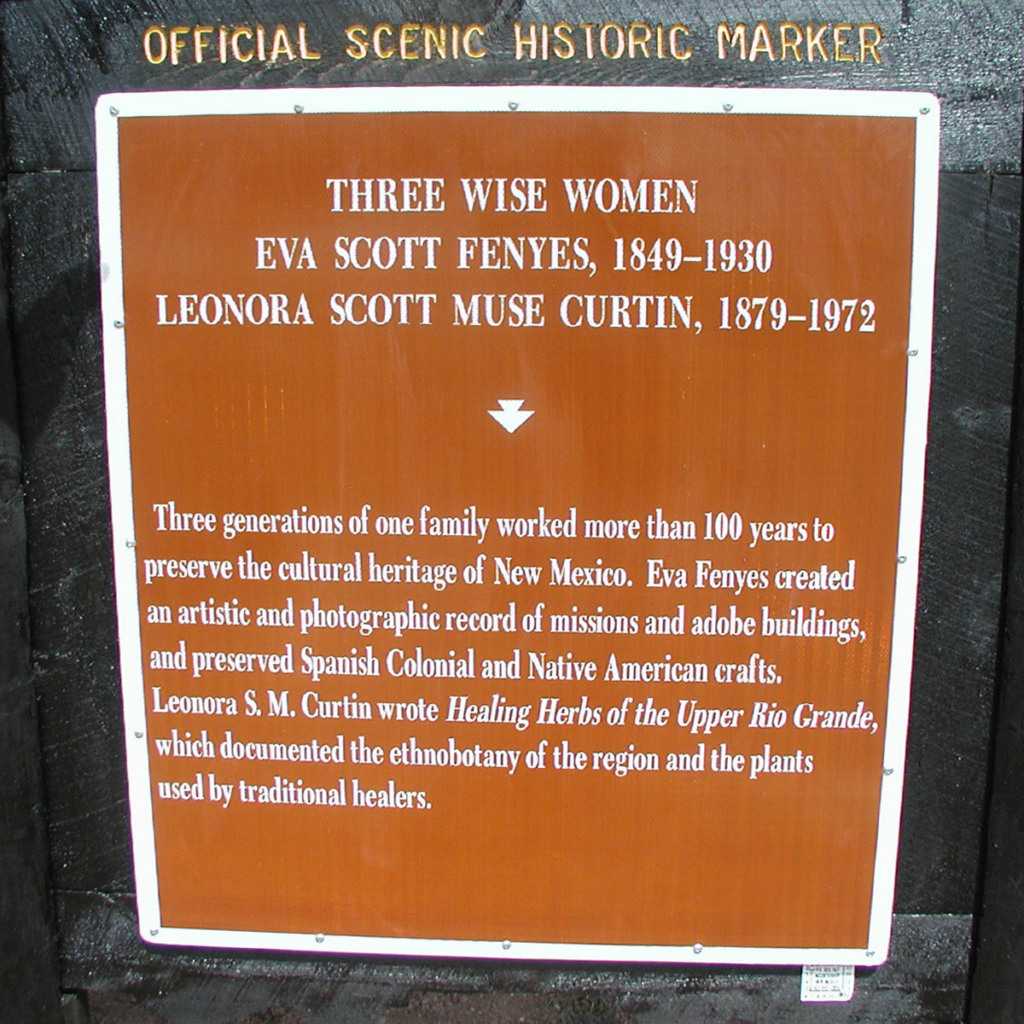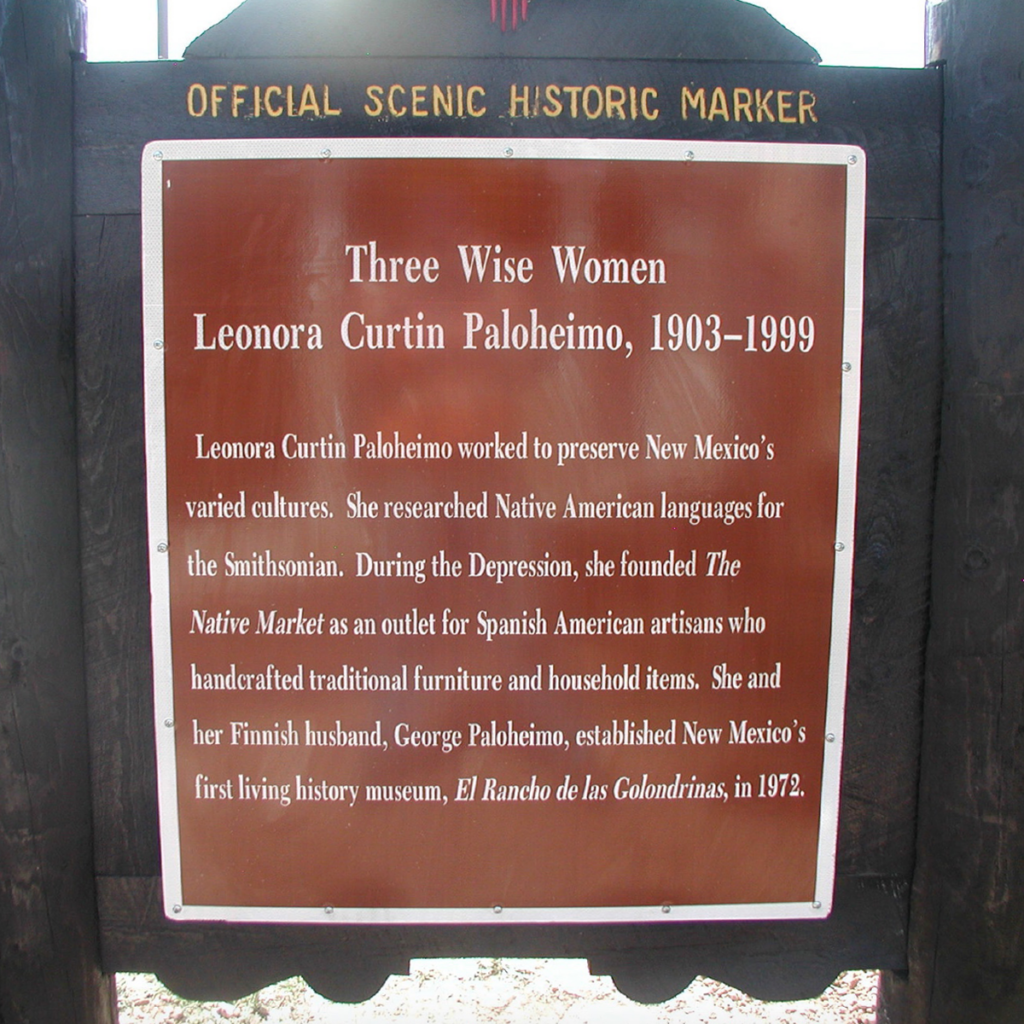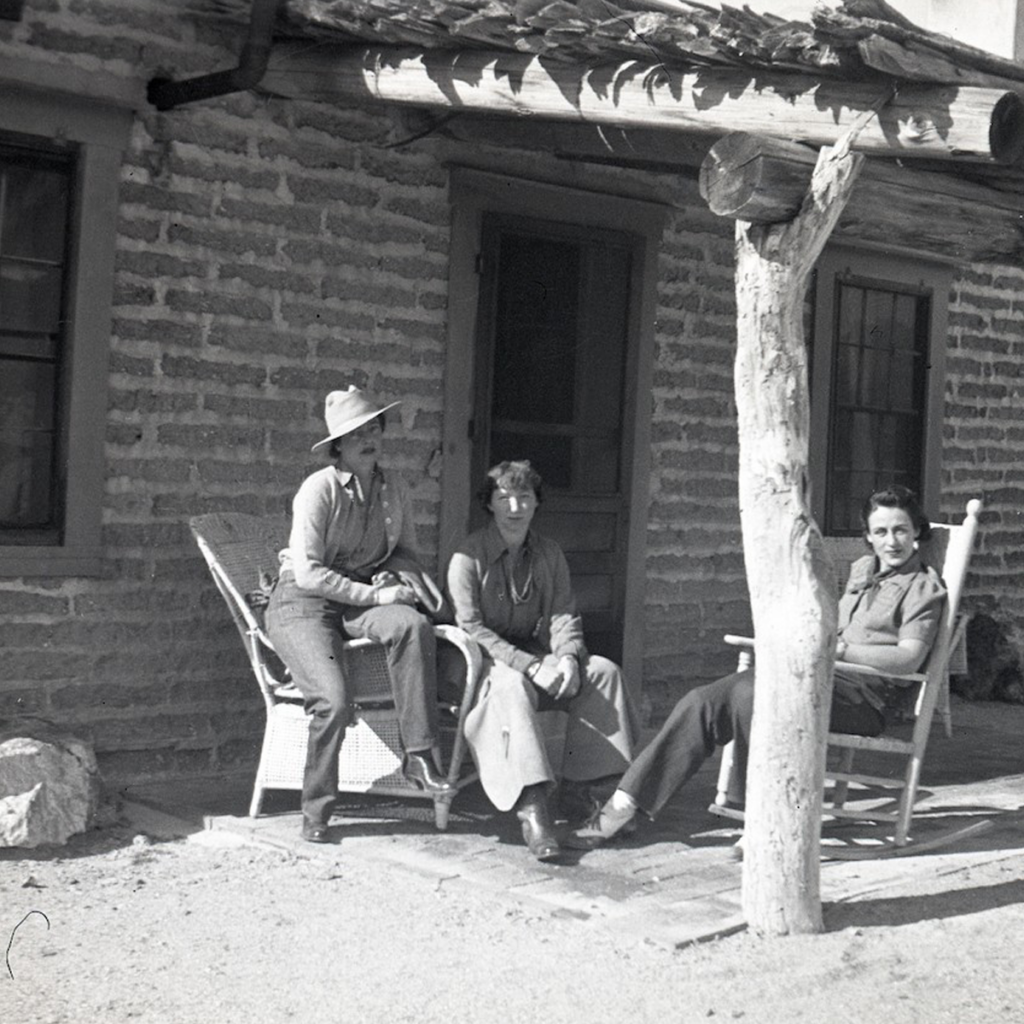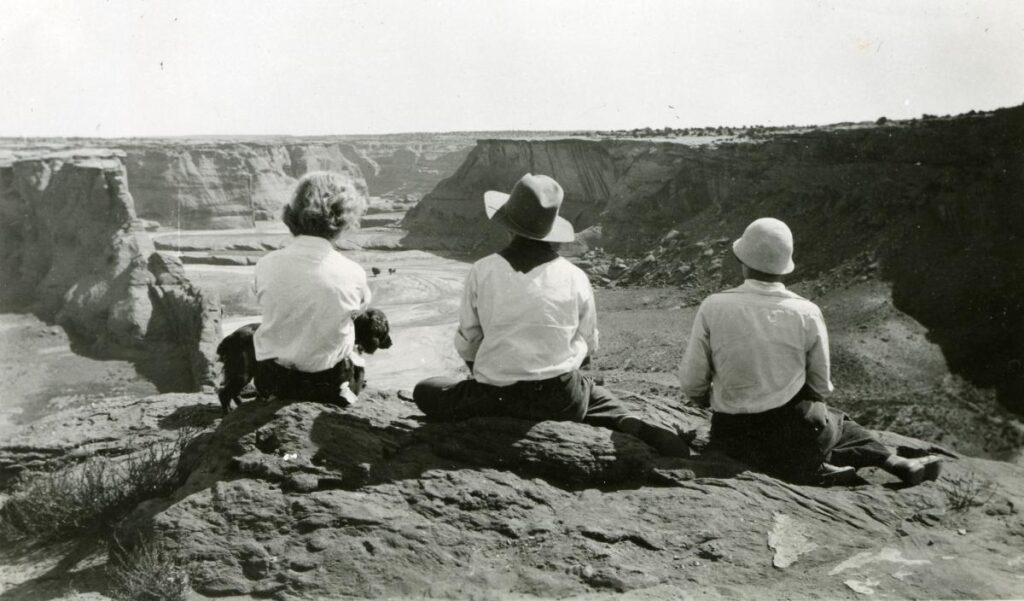Eva Scott Fényes, Leonora Scott Muse Curtin, and Leonora Frances Curtin Paloheimo and the Acequia Madre House.®
Three Wise Women: Eva Scott Fényes, Leonora Scott Muse Curtin, and Leonora Frances Curtin Paloheimo and the Acequia Madre House®
1849 - 1999
Santa Fe County
These astute businesswomen contributed to the establishment of prominent cultural institutions still in existence throughout the world, including their former home, the Acequia Madre House®, now a museum holding treasured collections of books, art, furniture, and textiles, as well as thousands of photographs.
Eva Scott Fényes (1849-1930), Leonora Scott Muse Curtin (1879-1972), and Leonora Frances Curtin Paloheimo (1903-1999)—mother, daughter, and granddaughter—were three visionary women ahead of their time who were not constrained by societal codes. They were primarily self-taught, well read in diverse subjects, able to speak several languages fluently, and held a deep and abiding interest in world cultures.
Collectively these astute businesswomen developed means to support their interests philanthropically. They contributed to the establishment of prominent cultural institutions still in existence in the United States and abroad. Their stewardship of the fortune they built together is now held in trust by their family foundation, which supports these arts, humanities, and sciences institutions so they can remain open today for scholars and public enjoyment.
The three generations of women, whose lives spanned 150 years of the 19th and 20th centuries, designed and built their homes at Acequia Madre House® in Santa Fe, New Mexico, an estate that still stands today, much the same as it was when completed in 1926. Designated special museum status by the City of Santa Fe, Acequia Madre House® now holds treasured collections of books, art, furniture, and textiles, as well as thousands of photographs and letters capturing the stories of the three women’s lives in the Southwest and around the world from 1849-1999.
The Acequia Madre House is also home to the Women’s International Study Center, which celebrates the legacy of the three women through fellowships in residence in the arts, sciences, cultural preservation, business, and philanthropy.
In addition to their shared skills and interests, each excelled in her own area of focus. Fényes was a talented artist whose watercolor paintings captured landscapes and architecture of the West and Southwest during the turn of the 19th century. Her paintings are now in the permanent collection of the Autry Museum of the American West in Los Angeles. Curtin was a keen ethnobotanist focused on antecedents and practices in the herbal traditions of Northern New Mexico. Her study during the first several decades of the 20th century is a landmark in research and an invaluable resource to herbalists today. Paloheimo was a skilled linguistics researcher and visionary social philanthropist whose recordings of Native American Indian languages and songs in the 1930s are held in the collection of the Library of Congress. Her work with Northern New Mexico artisans during the depression evolved into robust cultural institutions and celebrations still practiced today.
Paloheimo and her husband also founded El Rancho de las Golondrinas which is the Southwest’s premier living history museum.
In the words of historians Virginia Scharff and Carolyn Brucken, Fényes, Curtin, and Paloheimo formed a “remarkable female dynasty” unlike any other. They built and were stewards of their fortunes and through their studies and philanthropic work made a profound impact on our ability to research and enjoy what might otherwise be unknown facets of Finnish and American Southwest cultural heritage from the late 19th and early 20th centuries.
Eva Scott Fényes (1849-1930)
Eva Fényes was born to a family with roots in America’s early history. The only child of wealthy New York publisher Leonard Scott, she was tutored by her father in business affairs. She became a successful investor in her own right, acquiring securities and property in years when a woman was regarded as a novelty in financial circles. Her first husband, U.S. Marine General W.S. Muse, was the father of her daughter, Leonora, born in 1879. An accomplished artist, Eva’s studies took her to Egypt where she met her second husband, a Hungarian nobleman, physician Dr. Adalbert Fényes. In 1896, the family settled in Pasadena, California.
Eva Scott Fényes first lived in New Mexico in the 1880s and was an early champion of Spanish Colonial and Native American art and history. In California, her home became a salon and meeting place for the burgeoning art colony in Pasadena. At the urging of Los Angeles Times editor, Charles Lummis, she documented the fragile condition of the California missions in hundreds of paintings and photographs that form a lasting record of these historic sites. The family home now houses The Pasadena Museum of History.
Leonora Scott Muse Curtin (1879-1972)
Leonora Curtin first came to Santa Fe with her mother, Eva, as a small child. She had a lifelong interest in the art and archaeology of Spanish and Native American New Mexico. She met her husband, Thomas E. Curtin, in Santa Fe where he was a lawyer in the District Attorney’s office. After their marriage, they lived in Colorado Springs where he developed railroads and resorts. He died when their daughter Leonora was eight years old, and the two Leonoras went to live in Pasadena. Mother, daughter, and grandmother traveled together around the world.
Founding members of the Spanish Colonial Arts Society, the two Leonoras especially loved New Mexico. Together they purchased the property in La Cienega that later became the living history museum, El Rancho de las Golondrinas. Mrs. Curtin collected information about the varieties and uses of local herbs and plants by both the Native American and Spanish American cultures interviewing local friends, curanderas, and native healers. This research resulted in two highly readable and respected books, By the Prophet of the Earth and Healing Herbs of the Upper Rio Grande.
Leonora Frances Curtin Paloheimo (1903-1999)
Leonora Paloheimo grew up in a world filled with the exuberance of art, history, archaeology, and the pursuit of knowledge. She spoke several languages before she started school and continued to learn many more during her lifetime. Her accomplishments in writing, poetry, art, and archaeology gave her access to every part of Santa Fe’s cultural life. She did research work for the Smithsonian Institution in the field of Native American languages in New Mexico and Washington, D.C., with John P. Harrington. Her desire to provide an outlet for local Spanish American craftsmen prompted her creation of The Native Market, a place for artisans to sell their traditional folk art and furniture during the difficult times of the 1930s.
After World War II, she met and married Finnish Consul, Y.A. Paloheimo. Together they founded international cultural organizations and museums. The family home in Pasadena served as the Finnish Consulate and was an active center of social and diplomatic events. The family property in La Cienega, New Mexico, was restored to become the living history museum, El Rancho de las Golondrinas.
Sources:
Driesbach, Janice T., Harvey L. Jones, and Katherine Church Holland. Art of the Gold Rush. University of California Press, 1998.
Curtin, Leonora S.M. By The Prophet of the Earth: Ethno-botany of the Pima. Tucson: The University of Arizona Press. A Complete Online Version of the Original Printed Book.
Padilla, Carmella, Photography by Jack Parsons, Foreword by Marc Simmons. El Rancho de las Golondrinas. Santa Fe:Museum of New Mexico Press, 2009.
Curtin, Leonora S.M. Healing Herbs of the Upper Rio Grande. Santa Fe:Laboratory of Anthropology, 1947, Revised edition by Michael Moore, 1997.
Watter, Sam. Houses of Los Angeles, 1885-1919, Volume I. New York:Acanthus Press, 2007.
Bandelier, Adolph and Edgar Hewitt, Illustrations by Eva Scott Fenyes. Indians of the Rio Grande Valley. Albuquerque:The University of New Mexico, 1937.
Gerdts, William H. Masters of Light: Plein-Air Painting in California 1890-1930. The Irvine Museum, 2002.
Nestor, Sara. The Native Market of the Spanish New Mexican Craftsman: Santa Fe 1933-1940. Santa Fe:Colonial New Mexico Historical Foundation, 1979.
Benson, Nancy. New Mexico Colcha Club: Spanish Colonial Embroidery & The Women Who Saved It. Santa Fe:Museum of New Mexico Press, 2008.
Taylor, Lonn and Dessa Bokides. New Mexican Furniture 1600-1940: The Origins, Survival and Revival of Furniture Making in the Hispanic Southwest. Santa Fe:Museum of New Mexico Press, 1987.
Coulter, Lane and Maurice Dixon, Jr. New Mexican Tinwork, 1840-1940. Albuquerque:University of New Mexico Press, 1990.
Fisher, Nora. Rio Grande Textiles: A New Edition of Spanish Textile Tradition of New Mexico and Colorado. Santa Fe:Museum of New Mexico Press, 1994.
Smithsonian Institution, Archives of American Art, Collections A-Z, Eva Fenyes scrapbook on Santa Fe Art Colony artists 1870-1921.
Pierce, Donna and Marta Weigle, eds. Spanish New Mexico: The Spanish Colonial Arts Society Collection. Santa Fe:Museum of New Mexico Press, 1996.
Fenyes, Eva Scott and Isabel Lopez de Fages. Thirty-Two Adobe Houses of Old California. Los Angeles:Southwest Museum, 1950.
Directions:
Three Wise Women: Eva Scott Fényes, Leonora Scott Muse Curtin, and Leonora Frances Curtin Paloheimo and the Acequia Madre House®
Santa Fe County
Cultural preservationist | Entrepreneur | Philanthropist |
Statehood (1912 - present) | Territorial Period (1848 - 1912) |
North Central










